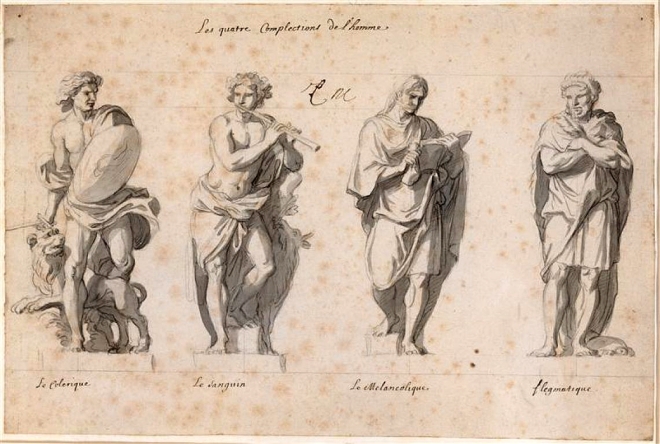The four Galenic temperaments are the Choleric (hot and dry, like fire), Sanguine (hot and moist, like the air), Phlegmatic (cold and moist, like water), and Melancholic (cold and dry, like the earth). The kinds of ailments that each type is predisposed to is determined by the combination of qualities to which they correspond (their krasis). Some general indications are given in the next section. But first, how do you know which temperament (or combination of temperaments) you are? Let me propose some simple questions the answers to which will afford some clues.
- Do you suffer particularly in hot weather or cold weather? Choleric and Sanguine temperaments suffer in hot weather, Phlegmatic and Melancholic temperaments in cold weather.
- Do you express your emotions freely (Choleric and Sanguine), or do you keep them to yourself (Phlegmatic and Melancholic)?
- Do you tend to a more rounded figure (Sanguine, Phlegmatic) or are you lean or thin (Choleric, Melancholic)?
- Do you get angry very easily (Choleric)?
- Do you get worried very easily (Sanguine)?
- Do you have a very stable temperament (Phlegmatic)?
- Do you get depressed easily (Melancholic)?
- Are you a person of action (Choleric)?
- Are you an artistic person (Sanguine)?
- Are you a particularly philosophical person (Melancholic)?
- Would you make a good judge (Phlegmatic)?
 Les Quatre Temperaments by Charles Le Brun, part of a series of designs made in the 17th century for the Grande Commande statues, commisioned by Louis XIV to decorate the gardens of the Palace of Versailles.
Les Quatre Temperaments by Charles Le Brun, part of a series of designs made in the 17th century for the Grande Commande statues, commisioned by Louis XIV to decorate the gardens of the Palace of Versailles.
Apart from a person’s temperament, there is another important factor to consider that affects their predisposition to disease as well as their response to treatment, and that is the availability of vital resources, or, you might say, their overall energy level. Some people are just more energetic than others regardless of temperament. That is, two healthy people of the same temperament may have different energy levels. Those with lower energy levels recuperate from disease more slowly. It would be a mistake to attempt to “stimulate” their systems too vigorously, because that would exhaust them. They need nourishment instead. On the other hand some people with high energy levels may need stimulation in order that their energy is mobilised in such a way that self-regulatory mechanisms are activated. They are less in need of nourishment. Do not take these examples as general rules, they are simply meant to illustrate that energy level (vital resources) is another factor in disease and healing.
